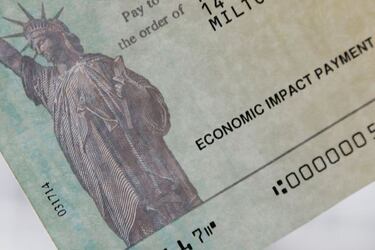Third stimulus check: what are the differences between an EIP card and a stimulus check?
The IRS and US Treasury began sending out 37 million stimulus payments this week. Of those, 15 million were paper checks and 5 million were pre-paid EIP debit cards.

The Internal Revenue Service (IRS) and US Treasury began sending out 37 million stimulus payments to Americans this week, payments totalling almost $83 billion. Of those, 15 million were issued as paper checks and approximately 5 million were pre-paid EIP debit cards – both payment methods will be mailed out by post to addresses on file at the IRS. This third round of Economic Impact Payments is part of the American Rescue Plan Act of 2021 which was signed into law by President Joe Biden on 11 March 2021.
Third stimulus check: how to check its status with the IRS Get My Payment tool
How to cash out your third stimulus check EIP debit card
When was the first stimulus check sent out and how much was it?
Second batch of stimulus payments have start to go out
Around 160 million Americans will have already received or are due to receive a direct payment worth up to $1,400 per person. The vast majority of those payments have been made through direct deposit with the money transferred automatically into individuals’ bank accounts. Out of the first batch of 90 million stimulus payments which started going out on 12 March, all apart from around 150,000 were issued via direct deposit; the rest were sent as paper checks.
If the IRS doesn't have sufficient information on file for the recipients – for example, they don't have your current, bank account details, stimulus payments will be made either with physical stimulus checks or Economic Impact Payment (EIP) debit cards posted by mail to the recipient’s home address. The Bureau of the Fiscal Service (BFS), another part of the Treasury Department that works with IRS, makes the decision as to who gets which form of payment.
Paper checks and EIP debit cards began processing on Friday 19 March and will continue to be sent by mail over the next few weeks. The EIP debit cards will need to be produced and distributed, meaning that the process may take longer. In the two previous rounds of stimulus aid, they started to arrive around a week after the paper checks. They will arrive in a white envelope from the US Department of the Treasury.

How to identify an authentic $1,400 stimulus paper check
In this third round of stimulus aid, the paper check will look similar to those which were issued in April and December last year but with a few subtle, visual differences. They bear the United States Treasury hallmark and seal (“Bureau of the Fiscal Service”) - this seal is printed with security ink to deter counterfeiters. Other features include microprinted text on the reverse which is invisible to the naked eye, a watermark - “US TREASURY” can be seen when the check is held up to light, plus an ultraviolet spot coating which appears under the payee information.
Once you receive your stimulus check, it may be cashed at a bank, a credit union and some large grocery stores and retailers although you may be charged a handling fee – Walmart for instance, charges $4 to cash a paper stimulus check of up to $1,000 and $8 to cash a check of $1,000–$5,000. Find out more about how and where you can cash a paper stimulus check here:
Since the 3rd round of Economic Impact Payments includes more mailed payments, #IRS urges people to carefully watch their mail in the coming weeks. If you’re still waiting for your payment, see https://t.co/6aL9Y7oNMx #COVIDreliefIRS pic.twitter.com/nCiVDXtzcT
— IRSnews (@IRSnews) March 26, 2021
How to identify and use EIP debit cards
A small number of people may receive their stimulus payment as an Economic Impact Payment Card (EIP Card) - a prepaid debit card that the US Treasury used as an alternative to direct deposits and paper checks. The Treasury’s financial agent, MetaBank, will mail out the EIP Cards to eligible recipients. Each mailing will include instructions on how to activate and use the card, or you can visit the EIP card website to activate it and learn more about how to use it if you receive one.
Related stories
The EIP Card works just like any other Visa debit card, although you will need to activate it when you receive it by setting your own personal, four-digit PIN number. The EIP Card has the VISA name on the front of the card and the issuing bank name, MetaBank® N.A. on the back. Instructions on how to securely activate and use the EIP Card are included on a separate sheet. EIP cards can be used to make purchases online or in stores anywhere Visa® Debit Cards are accepted, get cash from in-network ATMs and transfer funds to your personal bank account without a fee.
The IRS provided an example of what the new EIP Cards and the envelope it will arrive in look like here:
- Coronavirus stimulus checks
- USA coronavirus stimulus checks
- Visa
- Joseph Biden
- Covid-19 economic crisis
- Science
- Coronavirus Covid-19
- Economic crisis
- Pandemic
- Coronavirus
- Recession
- United States
- Banks
- Economic climate
- Virology
- Outbreak
- Infectious diseases
- North America
- Microbiology
- Diseases
- Enterprises
- Medicine
- America
- Bank
- Economy
- Finances
- Biology
- Health
- Life sciences

